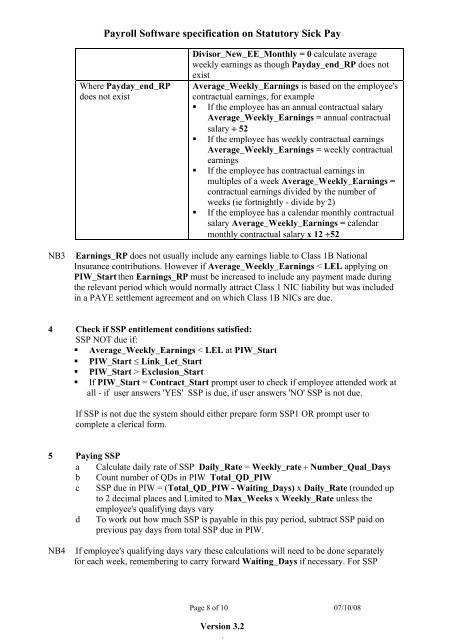Payroll Software specification on Statutory Sick Pay - HM Revenue ...
Payroll Software specification on Statutory Sick Pay - HM Revenue ...
Payroll Software specification on Statutory Sick Pay - HM Revenue ...
Create successful ePaper yourself
Turn your PDF publications into a flip-book with our unique Google optimized e-Paper software.
<str<strong>on</strong>g><strong>Pay</strong>roll</str<strong>on</strong>g> <str<strong>on</strong>g>Software</str<strong>on</strong>g> <str<strong>on</strong>g>specificati<strong>on</strong></str<strong>on</strong>g> <strong>on</strong> <strong>Statutory</strong> <strong>Sick</strong> <strong>Pay</strong><br />
Where <strong>Pay</strong>day_end_RP<br />
does not exist<br />
Divisor_New_EE_M<strong>on</strong>thly = 0 calculate average<br />
weekly earnings as though <strong>Pay</strong>day_end_RP does not<br />
exist<br />
Average_Weekly_Earnings is based <strong>on</strong> the employee's<br />
c<strong>on</strong>tractual earnings, for example<br />
If the employee has an annual c<strong>on</strong>tractual salary<br />
Average_Weekly_Earnings = annual c<strong>on</strong>tractual<br />
salary ÷ 52<br />
If the employee has weekly c<strong>on</strong>tractual earnings<br />
Average_Weekly_Earnings = weekly c<strong>on</strong>tractual<br />
earnings<br />
If the employee has c<strong>on</strong>tractual earnings in<br />
multiples of a week Average_Weekly_Earnings =<br />
c<strong>on</strong>tractual earnings divided by the number of<br />
weeks (ie fortnightly - divide by 2)<br />
If the employee has a calendar m<strong>on</strong>thly c<strong>on</strong>tractual<br />
salary Average_Weekly_Earnings = calendar<br />
m<strong>on</strong>thly c<strong>on</strong>tractual salary x 12 ÷52<br />
NB3 Earnings_RP does not usually include any earnings liable to Class 1B Nati<strong>on</strong>al<br />
Insurance c<strong>on</strong>tributi<strong>on</strong>s. However if Average_Weekly_Earnings < LEL applying <strong>on</strong><br />
PIW_Start then Earnings_RP must be increased to include any payment made during<br />
the relevant period which would normally attract Class 1 NIC liability but was included<br />
in a PAYE settlement agreement and <strong>on</strong> which Class 1B NICs are due.<br />
4 Check if SSP entitlement c<strong>on</strong>diti<strong>on</strong>s satisfied:<br />
SSP NOT due if:<br />
Average_Weekly_Earnings < LEL at PIW_Start<br />
PIW_Start ≤ Link_Let_Start<br />
PIW_Start > Exclusi<strong>on</strong>_Start<br />
If PIW_Start = C<strong>on</strong>tract_Start prompt user to check if employee attended work at<br />
all - if user answers 'YES' SSP is due, if user answers 'NO' SSP is not due.<br />
If SSP is not due the system should either prepare form SSP1 OR prompt user to<br />
complete a clerical form.<br />
5 <strong>Pay</strong>ing SSP<br />
a Calculate daily rate of SSP Daily_Rate = Weekly_rate ÷ Number_Qual_Days<br />
b Count number of QDs in PIW Total_QD_PIW<br />
c SSP due in PIW = (Total_QD_PIW - Waiting_Days) x Daily_Rate (rounded up<br />
to 2 decimal places and Limited to Max_Weeks x Weekly_Rate unless the<br />
employee's qualifying days vary<br />
d To work out how much SSP is payable in this pay period, subtract SSP paid <strong>on</strong><br />
previous pay days from total SSP due in PIW.<br />
NB4 If employee's qualifying days vary these calculati<strong>on</strong>s will need to be d<strong>on</strong>e separately<br />
for each week, remembering to carry forward Waiting_Days if necessary. For SSP<br />
Page 8 of 10 07/10/08<br />
Versi<strong>on</strong> 3.2<br />
.

















